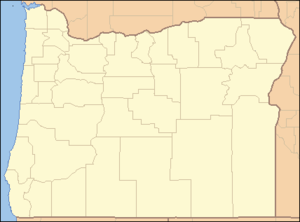Fanno Creek
| Fanno Creek | |
|
Fanno Creek in Greenway Park, Beaverton
|
|
| Name origin: Augustus Fanno, early settler | |
| Country | United States |
|---|---|
| State | Oregon |
| County | Multnomah and Washington |
| Source | Tualatin Mountains (West Hills) |
| - location | Portland, Multnomah County, Oregon |
| - elevation | 478 ft (146 m) |
| - coordinates | 45°28′44″N 122°42′00″W / 45.47889°N 122.70000°W |
| Mouth | Tualatin River |
| - location | Durham, Washington County, Oregon |
| - elevation | 108 ft (33 m) |
| - coordinates | 45°23′35″N 122°45′50″W / 45.39306°N 122.76389°WCoordinates: 45°23′35″N 122°45′50″W / 45.39306°N 122.76389°W |
| Length | 15 mi (24 km) |
| Basin | 31.7 sq mi (82.1 km2) |
| Discharge | for Durham, 1.13 miles (1.82 km) from mouth |
| - average | 43.9 cu ft/s (1.24 m3/s) |
| - max | 1,670 cu ft/s (47.29 m3/s) |
| - min | 1 cu ft/s (0.03 m3/s) |
|
Fanno Creek watershed
|
|
Fanno Creek is a 15-mile (24 km) tributary of the Tualatin River in the U.S. state of Oregon. Part of the drainage basin of the Columbia River, its watershed covers about 32 square miles (83 km2) in Multnomah, Washington, and Clackamas counties, including about 7 square miles (18 km2) within the Portland city limits.
From its headwaters in the Tualatin Mountains (West Hills) in southwest Portland, the creek flows generally west and south through the cities of Portland, Beaverton, Tigard and Durham, and unincorporated areas of Washington County. It enters the Tualatin River about 9 miles (14 km) above the Tualatin's confluence with the Willamette River at West Linn.
When settlers of European origin arrived, the Kalapuya lived in the area, having displaced the Multnomahs in pre-contact times. The first settler of European descent, Augustus Fanno, for whom the creek is named, arrived in the mid-19th century. He established an onion farm in what became Beaverton. Fanno Farmhouse, the restored family home, is a Century Farm on the National Register of Historic Places and is one of 16 urban parks in a narrow corridor along the creek.
...
Wikipedia



